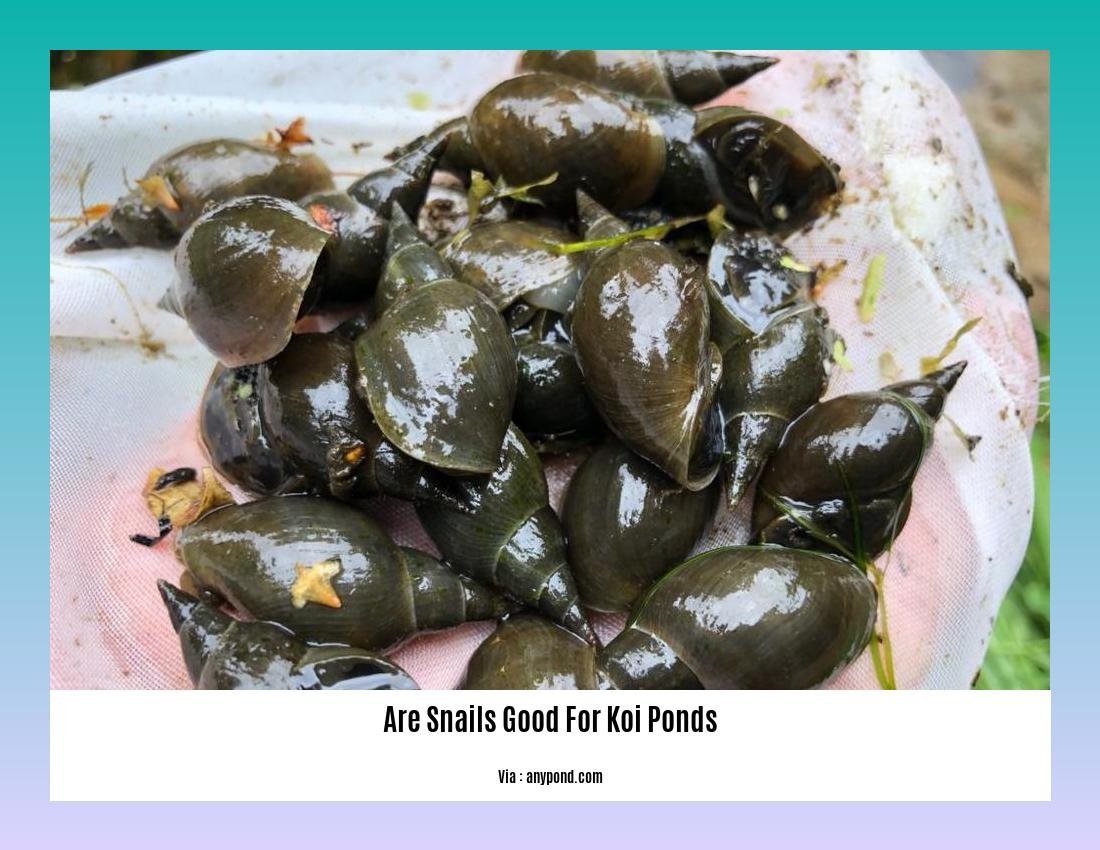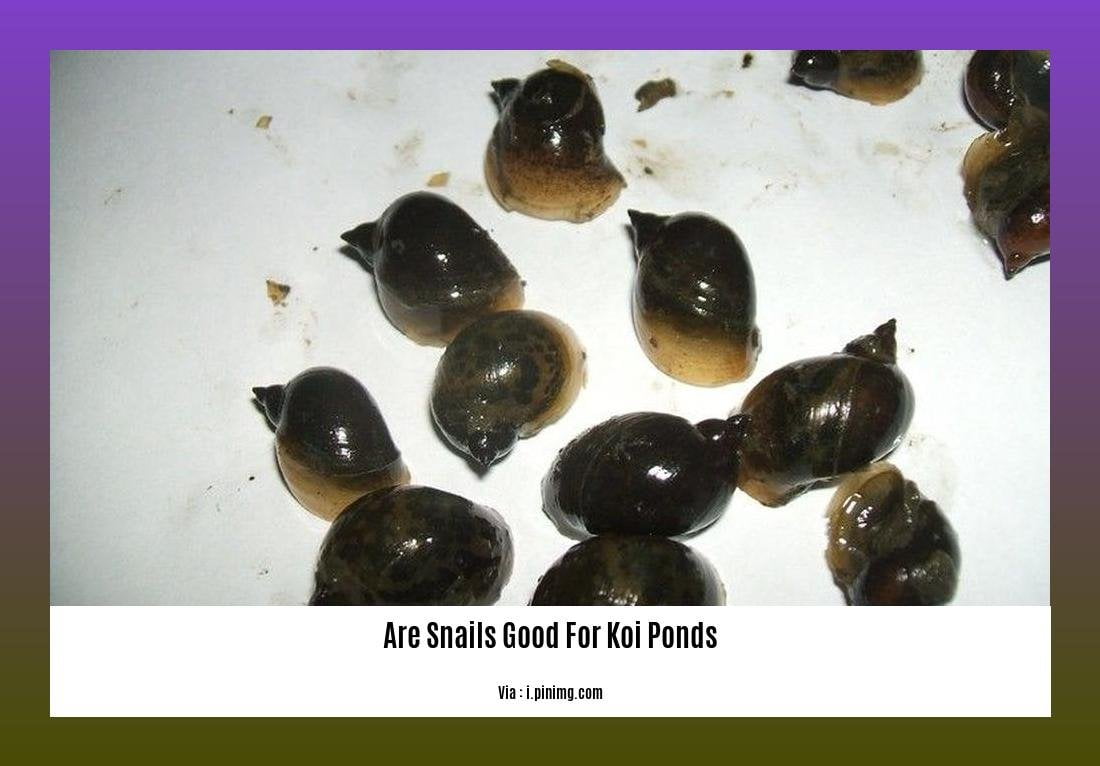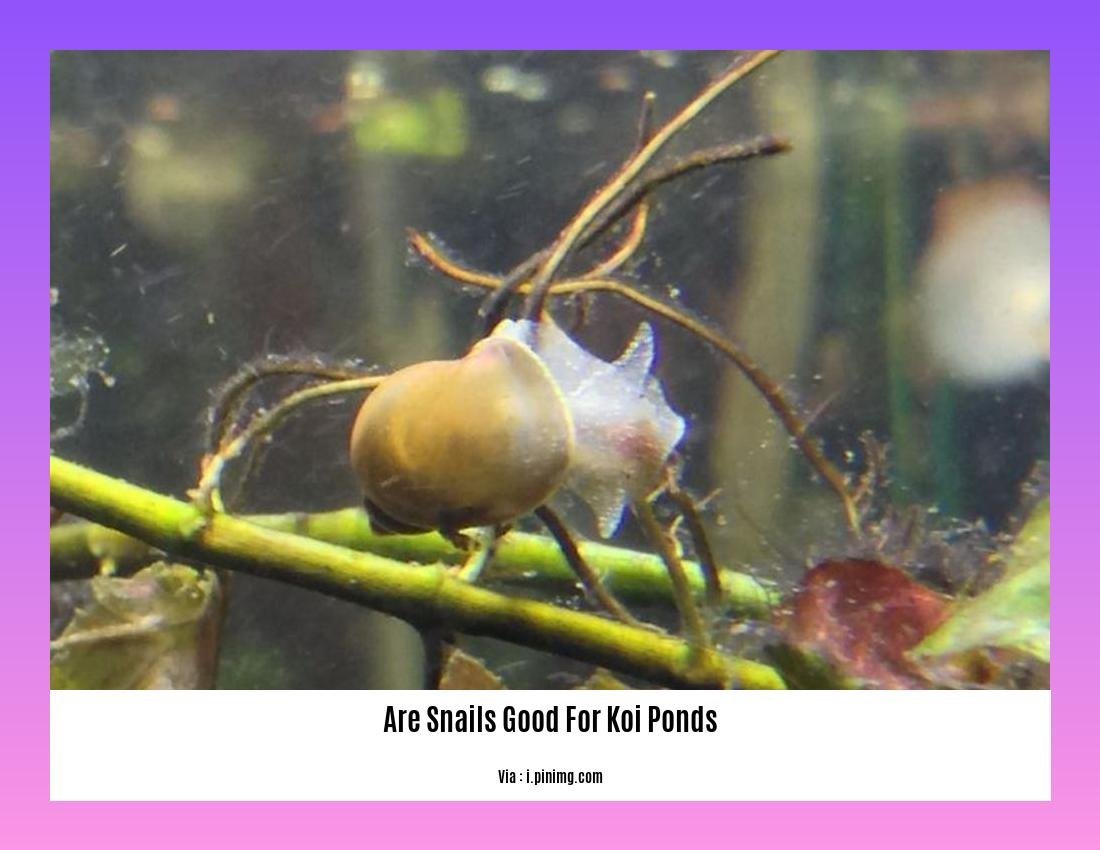Are snails good for koi ponds? Exploring the Beneficial Role of Snails in Maintaining a Thriving Ecosystem.
If you have ever owned a koi pond, you understand the delicate balance required to create a thriving ecosystem for these vibrant and prized fish. One often-overlooked element in this intricate web of life is the humble snail. While some may view snails as nuisances, they actually play a crucial role in maintaining the health and balance of a koi pond. In this article, we will dive into the world of snails and explore their beneficial role in keeping koi ponds flourishing. From what snails eat to the best snail species for outdoor ponds, we will provide valuable insights and practical advice for anyone looking to enhance the wellbeing of their cherished fish.
Key Takeaways:
- Snails in koi ponds have both positive and negative impacts.
- The positive side of having snails in a koi pond is that they can control algae and other organic matter, leading to cleaner water and better overall pond health.
- However, snails can become a problem when they start eating desired pond plants, such as Lilies.
- Despite the potential negative effects on pond plants, snails can still be beneficial for koi ponds as they help control waste and contribute to overall balance.
- It is important to find a balance and manage the snail population to minimize their impact on plant life.
- When introducing snails to a koi pond, it is recommended to choose the right species and size.
- For larger koi fish or as a precautionary measure, Trapdoor Snails of ping pong ball size are suggested as they can withstand the attention of koi without causing harm to the fish.
- Snails can aid in algae control and contribute to the overall balance of the ecosystem in koi ponds.
- Pond owners should be aware of the potential impact of snails on pond plants and take measures to manage the snail population accordingly.
Are Snails Good for Koi Ponds?

Snails in koi ponds can play a beneficial role in maintaining a thriving ecosystem. They can help control algae and organic matter, which leads to cleaner water and better overall pond health. However, it’s important to strike a balance because snails can also pose challenges, especially when they start eating desired pond plants like lilies.
The Benefits of Snails in Koi Ponds
Snails serve as natural cleaners in koi ponds. They consume algae and decaying organic matter, contributing to a healthier and more balanced ecosystem. This helps to prevent excessive algae growth, which can cause water quality issues.
By devouring these unwanted substances, snails indirectly contribute to the welfare of koi fish. Cleaner water promotes better fish health and reduces the risk of diseases caused by poor pond conditions. Snails also aid in the breakdown of fish waste, helping to maintain water clarity.
The Drawbacks of Snails in Koi Ponds
While snails offer several benefits, they can become problematic when they start feeding on pond plants, particularly if you have invested in these plants as key features in your pond. Some snail species have a tendency to eat lilies and other desirable aquatic plants, which can be disheartening for pond owners.
Balancing the Snail Population
To maximize the benefits of snails while minimizing their impact on pond plants, it’s important to manage the snail population carefully. When introducing snails to a koi pond, selecting the right species and size is crucial.
If you have smaller fish in your pond, they may consume smaller snails without causing harm. However, larger fish, such as adult koi, may find smaller snails to be a tasty snack. To be on the safe side, it is recommended to introduce Trapdoor Snails when they are about the size of a ping pong ball. These snails are hardy and can withstand the attention of koi without causing harm to the fish.
Conclusion
In summary, snails can be beneficial for koi ponds by aiding in algae control and contributing to the overall balance of the ecosystem. However, pond owners should be aware of their potential impact on pond plants and take measures to manage the snail population accordingly. Finding the right balance between the benefits and drawbacks of snails is essential for maintaining a thriving koi pond.
Table:
| Pros of Snails in Koi Ponds | Cons of Snails in Koi Ponds |
|---|---|
| Help control algae and organic matter | May eat desirable pond plants like lilies |
| Contribute to cleaner water and better overall pond health | Can be challenging to manage the snail population |
| Aid in the breakdown of fish waste | |
| Contribute to a balanced ecosystem | |
| Promote better fish health |
Remember, striking a balance and managing the snail population is key to ensuring the overall health and beauty of your cherished koi pond.
Are snails good for your pond? Find out the answer here: are snails good for my pond.
Curious about the benefits of having snails in ponds? Discover why snails can be a positive addition to your water feature: are snails good for ponds.
If you live in the UK and have a pond, you might be wondering if snails are beneficial. Learn more about the advantages of having snails in your ponds in the UK: are snails good for ponds uk.
Pond Snails: Good or Bad For My Pond?

Snails in koi ponds, are they beneficial or detrimental? This article explores the role of snails in maintaining a thriving ecosystem in your pond.
The Benefits of Snails in Koi Ponds
Snails have a range of advantages when introduced to koi ponds:
Natural Algae Control: These delicate creatures act as a natural algae control method, reducing excessive algae growth and promoting clearer water quality.
Nutrient Cycling: Snails contribute to nutrient cycling in the pond by breaking down organic matter and recycling the nutrients back into the ecosystem. This helps maintain a balanced and healthy pond environment.
Aesthetic Value: Certain types of snails, such as apple snails or mystery snails, can add visual interest and variety to your pond’s ecosystem. They can enhance the overall aesthetic appeal of your pond.
According to Tricky Fish, snails are indeed beneficial for koi ponds as they act as a form of cleanup crew, helping to maintain the aquatic ecosystem through scavenging leftover food and organic debris.
When it comes to preventing snails from eating plants, it is essential to employ specific strategies to deter them. These strategies may include creating barriers, using snail-repellent substances, or maintaining a balanced ecosystem in the pond to discourage excessive snail populations (source: The Goldfish Tank).
Attracting snails to your pond can be achieved by providing suitable habitats such as plants, rocks, or structures, where snails can find food and shelter (source: Pond Informer).
Potential Drawbacks of Snails in Koi Ponds
While advantages are apparent, it is vital to consider potential drawbacks as well. Though not extensively mentioned in the provided context, it is important to note that some pond snail species may consume frogspawn or occasionally feed on dead or dying fish if other food sources are scarce in the pond (source: Pond Expert).
Key Takeaways:
- Snails can bring numerous benefits to your koi pond, including natural algae control, nutrient cycling, and enhanced aesthetic appeal.
- To manage potential drawbacks, it is crucial to employ strategies to prevent them from damaging pond plants or causing issues in the ecosystem.
- Creating barriers, utilizing snail-repellent substances, and maintaining a balanced pond environment can help discourage excessive snail populations and protect desired plants.
Citations:
– Tricky Fish – Are Snails Good for Koi Ponds?
– The Goldfish Tank – Guide to Pond Snails
– Pond Informer – Guide to Garden Pond Snails
– Pond Expert – Pond Snails in Your Pond
What Do Pond Snails Eat?
Pond snails play a crucial role in maintaining the health and balance of a koi pond ecosystem. These little creatures act as nature’s cleanup crew, feasting on various food sources and contributing to cleaner water and a thriving environment. But what exactly do pond snails eat? Let’s dive into their diet and shed some light on this fascinating topic.
Understanding the Diet of Pond Snails
Pond snails are opportunistic feeders, meaning they will eat whatever food source is available to them. Their diet consists of a wide range of organic matter found in the pond, including algae, decaying plant material, and microorganisms. These adaptable creatures can even graze on soft green algae, which provides them with essential nutrients.
Algae Control
One of the key benefits of having snails in your koi pond is their ability to control algae growth. Snails have a voracious appetite for algae, making them excellent natural algae eaters. They prefer algae over vegetation, allowing them to contribute to clearer and cleaner water by reducing algae blooms.
Contribution to Ponds’ Ecosystem
Snails are an integral part of the pond’s ecosystem. They aid in nutrient cycling by breaking down decaying plant matter and organic debris, preventing the buildup of waste. By doing so, they help maintain a healthier and more balanced environment for your koi and other pond inhabitants.
Suitable Water Conditions
Another remarkable aspect of pond snails is their ability to tolerate different water conditions, including soft water. This adaptability makes them well-suited for various types of ponds and ensures their survival in diverse environments.
Attracting Snails to Your Pond
If you want to attract snails to your koi pond, it’s essential to provide suitable habitat, food sources, and water conditions. Creating a hospitable environment with rocks, plants, and adequate hiding spots will encourage these fascinating creatures to take up residence in your pond.
Maintaining a Balanced Snail Population
The number of snails needed for a koi pond will depend on the specific needs of your pond. It’s important to strike a balance and avoid overpopulating the pond with snails. Each pond is unique, and finding the right snail population will help prevent any potential issues that may arise from an excessive snail presence.
Benefits and Drawbacks of Snails in Koi Ponds
While snails offer numerous benefits to koi ponds, it’s important to be aware of potential drawbacks as well. Snails can become problematic when they start feeding on desired pond plants, such as lilies. Managing the snail population and finding a balance between their positive contributions and potential impact on plant life is essential.
Conclusion
In conclusion, snails can be valuable assets to koi ponds, contributing to cleaner water, algae control, and overall pond health. Their diverse diet, adaptability to different water conditions, and crucial role in nutrient cycling make them a natural solution for maintaining a thriving pond ecosystem. By understanding what pond snails eat and how they contribute to the pond’s ecosystem, you can enhance the well-being of your cherished fish and create a more vibrant and enjoyable pond environment.
Key Takeaways:
– Pond snails eat algae, decaying plant matter, and microorganisms.
– They contribute to cleaner water and algae control in koi ponds.
– Snails help with nutrient cycling and maintaining a balanced ecosystem.
– Snails are adaptable to different water conditions, including soft water.
– Creating a suitable habitat and managing the snail population is important.
– Snails can have both benefits and drawbacks in a koi pond ecosystem.
Sources:
1. Remodel or Move – “How many snails do I need for a koi pond?”
2. Pond Heaven – “Snails in Koi Pond Filter: Is It Good or Bad, and What You Can Do”
FAQ
Q1: What eats pond snails?
A1: There are several species that prey on pond snails, including certain fish species like koi, goldfish, and bettas. Additionally, birds, turtles, and some larger invertebrates like crayfish and freshwater shrimps may also consume pond snails.
Q2: What are the best snails for outdoor ponds?
A2: Some of the best snail species for outdoor ponds include the Japanese trapdoor snail (Viviparus spp.), great pond snail (Lymnaea stagnalis), and ramshorn snail (Planorbis spp.). These snails are well-suited for outdoor ponds and can contribute to the overall health of the ecosystem.
Q3: Are pond snails good or bad for my pond?
A3: Pond snails can have both positive and negative impacts in a pond. They can help control algae, contribute to nutrient cycling, and aerate the water, which are beneficial for the pond ecosystem. However, some pond snail species may consume desirable pond plants and occasionally feed on dead or dying fish if other food sources are scarce. Therefore, their effects may vary depending on specific circumstances.
Q4: What do pond snails eat?
A4: Pond snails feed on a variety of food sources, including algae, decaying plant matter, and microorganisms. They are particularly fond of algae and prefer to consume algae over vegetation. Some pond snails may also graze on soft green algae.
Q5: How can I deter pond snails from eating my plants?
A5: To deter pond snails from eating plants, you can try creating barriers around the plants, using snail-repellent substances, or maintaining a balanced ecosystem in the pond to discourage excessive snail populations. Additionally, choosing snail species that are less likely to consume plants may also be beneficial.















